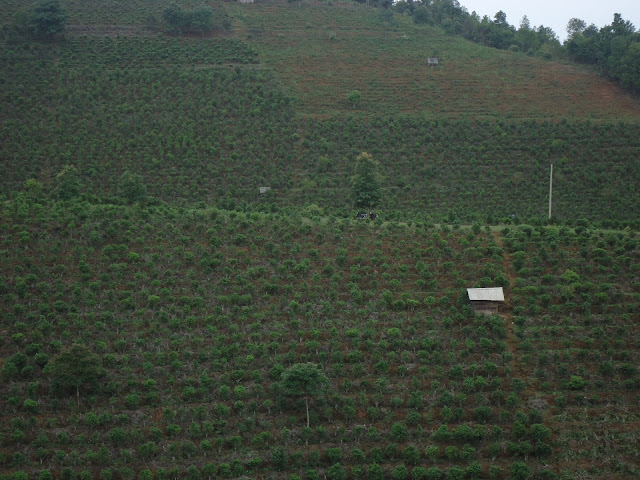
On Jingmai mountain, it has been decided to prohibit the use of insecticide and chemical fertilizer, and restrict the use of herbicide. In order to avoid massive pest invasion, the number of tea trees per hectare must be severely reduced (four trees out of five have been cut), the tea trees are now at least two meters far from each other. Shade trees are to be planted in order to host natural predators and improve the tea quality.

The locals can pick tea at lighting speed, according to them, it takes one month of training to reach the right pace. My picking speed was slow and, at the end of the day, my bag was very light compared to theirs. I find pretty hard to see the buds on the tea tree, that's why i couldn't pick the tea faster, I had to look at the tree, pick a few buds and leaves, and look again.
 |
| one bud one leaf |
In Jingmai mountain, there are two main species of trees: big leaf varietal and small-medium leaf. In reality, there is an important variation between the leaf shape of each tea tree. On some trees, they are round shaped, on others, they are longer and narrower, shaped like a boat. This explains the large diversity of leaves in the cakes, and it does not necessarily reveals a blended cake.

I was very happy to hike in the tea mountains again, and i learned a lot of new things about tea agriculture. I am a happy man forever!
 |
| a happy man! |


Must have been a great experience ! Thanks for sharing it with us.
ReplyDeleteAnd good news about the end of the use of insecticide and chemical fertilizer ! This will surely lead to better tea in the end.
Hello David,
ReplyDeleteI agree with you, restricting the use of agrochemicals will surely lead to a better tea and will increase the local's revenue, yield is much lower but tea from natural tea gardens is much more expensive than Taidi Cha. When the shade trees will grow up, it will make the mountain very attractive for tourists. Welcome to Jingmai!
Your tea is also universally red at the spot where you picked - seems like you bruised the tea more than a skilled picker would. Of course, none of us would be any good at it unless we've spent weeks (months? years?) practicing.
ReplyDeleteHello MarshalN,
ReplyDeleteSure there is a lot to learn to be a skilled tea picker, the trickiest for me was to know whether or not to pick the older leaves, even while harvesting 1 leaf/1 bud, you should only select the most tender leaves, but there is not obvious gap between tender and too old, some of the leaves in the bag are a bit too big compared to the majority.